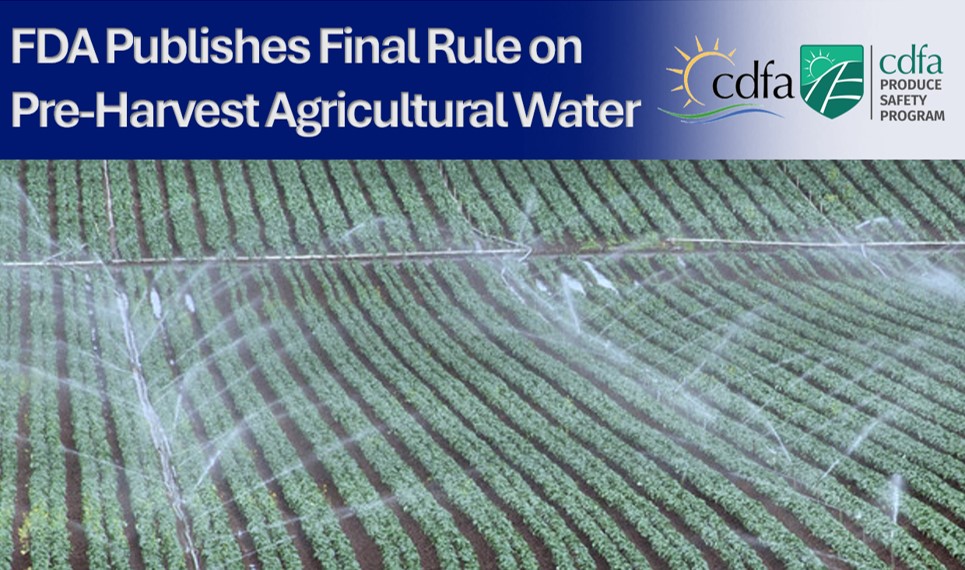On May 6, 2024, the U.S. Food and Drug Administration (FDA) published a final rule on pre-harvest agricultural water revising certain requirements in Subpart E of the FSMA Produce Safety Rule (PSR) for covered produce (other than sprouts) for enhanced produce safety.
The new rule replaces the prior pre-harvest water microbial quality criteria and testing requirements with requirements for systems-based agricultural water assessments for hazard identification and risk management. Agricultural water assessments will now need to be conducted once annually, and whenever a significant change occurs that increases the likelihood of hazards being introduced to produce or food contact surfaces. The new rule does not change existing agricultural water requirements for sprouts or harvest and post-harvest water uses.
FDA states this new rule:
- Establishes requirements for agricultural water assessments that evaluate a variety of factors that are key determinants of contamination risks associated with pre-harvest agricultural water. This includes an evaluation of the water system, water use practices, crop characteristics, environmental conditions, potential impacts on water from adjacent and nearby land, and other relevant factors.
- Includes testing pre-harvest agricultural water as part of an assessment in certain circumstances.
- Requires farms to implement effective mitigation measures within specific timeframes based on findings from their assessments. Hazards related to certain activities associated with adjacent and nearby land uses are subject to expedited mitigation.
- Adds new options for mitigation measures, providing farms with additional flexibility in responding to findings from their pre-harvest agricultural water assessments.
The final rule is effective July 5, 2024. Compliance dates for the pre-harvest agricultural water requirements for covered produce (other than sprouts) are as follows[1]:
- For Large farms: April 7, 2025 (9 months after the effective date of the final rule)
- For Small farms: April 6, 2026 (1 year, 9 months after the effective date of the final rule)
- For Very Small farms: April 5, 2027 (2 years, 9 months after the effective date of the final rule)
If you have questions about the Produce Safety Rule, please contact producesafety@cdfa.ca.gov.
- To stay up to date with news related to the California Department of Food and Agriculture (CDFA) Produce Safety Program, sign up for the Produce Safety Program Mailing List by checking the Inspection Services Division (ISD) / Produce Safety box
- To learn more about CDFA’s Produce Safety Program, please visit https://www.cdfa.ca.gov/producesafety/
Additional Resources:
- CFSAN Constituent Update: FDA Publishes Landmark Final Rule to Enhance the Safety of Agricultural Water
- FSMA Final Rule on Pre-harvest Agricultural Water: Annual Agricultural Water – Assessments and Risk-Based Outcomes
- FSMA Final Rule on Pre-harvest Agricultural Water
- FSMA Final Rule on Pre-harvest Agricultural Water: Corrective and Mitigation Measures for Pre-harvest Agricultural Water for Non-Sprout Covered Produce
- FSMA Final Rule on Pre-harvest Agricultural Water: Equivalent Testing Methodology for Agricultural Water Produce Safety Rule (21 CFR 112)
- FSMA Final Rule on Pre-harvest Agricultural Water: Factors for Agricultural Water Assessment to Consider
- FSMA Final Rule on Pre-harvest Agricultural Water: End of Intended Enforcement Discretion for Subpart E Requirements for Harvest and Post-Harvest Agricultural Water for Covered Produce Other than Sprouts – Beginning January 26, 2023
[1] Under the FSMA Produce Safety Rule, farms sizes are classified by the average annual gross produce sales adjusted for inflation over a 3-year period. Click here to learn more about the FSMA Inflation Adjusted Cut Offs. “Large” farms have average annual produce sales above $500,000 adjusted for inflation. “Small” farms have average annual produce sales above $250,000 and up to $500,000 adjusted for inflation. “Very Small” farms have average annual produce sales above $25,000 and up to $250,000 adjusted for inflation.


